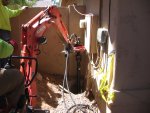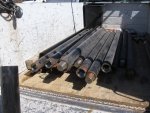What’s up guys. Been searching all over and haven’t found anything. Anybody have or have ever seen an implement for driving helical piles for Kubota ? I’m seeing them for skid steers and mini excavators but that’s it. I use to be a deck builder and just got turned onto these things. Nobody’s doing them where I’m at but man I’m certain I could create a market for them. It’s truly a game changer for the deck building racket. I would’ve been all over those things when I was building decks.
Helical pile implement
- Thread starter Chapstick
- Start date
its a flow rate thing.
my buddy owns a business that installs
his little one needs 20 gpm flow and prefers a high flow pump closer to 35 gpm.
final installation torque something like 10,00 psi when I watched him put in a string of solar panel racks.
they sell manual ones but doubt getting the "bite" to be great enough to be much value is likely suspect.
my buddy owns a business that installs
his little one needs 20 gpm flow and prefers a high flow pump closer to 35 gpm.
final installation torque something like 10,00 psi when I watched him put in a string of solar panel racks.
they sell manual ones but doubt getting the "bite" to be great enough to be much value is likely suspect.
GreensvilleJay
Well-known member
Equipment
BX23-S,57 A-C D-14,58 A-C D-14, 57 A-C D-14,tiller,cults,Millcreek 25G spreader,
You can just run it off a PTO powered pump/reservoir.
neighbour had some installed, real pricey ,but tight spot, couldn't drill a hole old school.
guy was a franchise company,that has custom baby 'dingo' machine.
neighbour had some installed, real pricey ,but tight spot, couldn't drill a hole old school.
guy was a franchise company,that has custom baby 'dingo' machine.
You can just run it off a PTO powered pump/reservoir.
neighbour had some installed, real pricey ,but tight spot, couldn't drill a hole old school.
guy was a franchise company,that has custom baby 'dingo' machine.

Dynamic Hydraulic Gear Pump 1.95 cu.in/rev, 30.39 GPM at MAX 3600 RPM
Dynamic Hydraulic Gear Pump 1.95 cu.in/rev, 30.39 GPM at MAX 3600 RPM. Usually ships in4 days. Buy it and Save at Globalindustrial.ca
Wonder if I could rig this up to the pto ? Could get a stand-alone motor too.
A contractor at work just drove 98 of them with a Bobcat E55 mini ex. with a hydraulic head. Driven to 9500The only helical pile unit I've seen was a self-propelled unit on tracks.
ft/lbs. A pier for a deck would be considerably less I would think. I have also seen small ones driven with a
pto post hole digger.
Chance Anchors was one of the early players in the helical anchor market. I always thought that was a heck of a name for something you want to be at least 150% sure of. Even if it was the owners last name.
If you can mount it to a Skid Steer you can probably mount it to a newer Kubota.
Having the power to run it is a different story.
They're talking about a max of 3600.
Having the power to run it is a different story.
The PTO probably won't have the RPMs for this.
Dynamic Hydraulic Gear Pump 1.95 cu.in/rev, 30.39 GPM at MAX 3600 RPM
Dynamic Hydraulic Gear Pump 1.95 cu.in/rev, 30.39 GPM at MAX 3600 RPM. Usually ships in4 days. Buy it and Save at Globalindustrial.cawww.globalindustrial.ca
Wonder if I could rig this up to the pto ? Could get a stand-alone motor too.
They're talking about a max of 3600.
North Idaho Wolfman
Moderator
Staff member
Lifetime Member
Equipment
L3450DT-GST, Woods FEL, B7100 HSD, FEL, 60" SB, 743 Bobcat with V2203, and more
NO.
Dynamic Hydraulic Gear Pump 1.95 cu.in/rev, 30.39 GPM at MAX 3600 RPM
Dynamic Hydraulic Gear Pump 1.95 cu.in/rev, 30.39 GPM at MAX 3600 RPM. Usually ships in4 days. Buy it and Save at Globalindustrial.cawww.globalindustrial.ca
Wonder if I could rig this up to the pto ? Could get a stand-alone motor too.
And using Dynamic's claimed 90% volumetic efficiency 1.95 CID @ 3600 RPM is 22.5 GPM
Dsn
GreensvilleJay
Well-known member
Equipment
BX23-S,57 A-C D-14,58 A-C D-14, 57 A-C D-14,tiller,cults,Millcreek 25G spreader,
yeesh, pump pushing 22 GPM needs a tank with 50 gallons of oil in it. The unit that did neighbor's pile sure didn't have that sized tank !
Hum. Using a 90% efficiency rate my math says about 27.35 gpm? Until you did it, it didn’t occur to me to check the math. Their number appears correct for 100% efficiency (clearly not realistic).NO.
And using Dynamic's claimed 90% volumetic efficiency 1.95 CID @ 3600 RPM is 22.5 GPM
Dsn
Ya caught meHum. Using a 90% efficiency rate my math says about 27.35 gpm? Until you did it, it didn’t occur to me to check the math. Their number appears correct for 100% efficiency (clearly not realistic).
Dont know what I did first time but my phone agrees with you this time.
I have put a number of the 1.95 CID Dynamic pumps on other tractors and that 35 GPM number started my Spidey Sense tingling.
You can also buy that pump for considerably less than $359. Going price from Burhan's has been $135 but I see its now up to $169.
Dan
Lil Foot
Well-known member
Lifetime Member
Equipment
1979 B7100DT Gear, Nissan Hanix N150-2 Excavator
Interesting. Thanks for sharing.
I presume the red jack was used to load test each anchor individually and the reaction force is provided from the outer collar that has a bracket secured to the house foundation, using the dead load of the house foundation as the reaction force. Once the jack is pushing on the outer collar (as shown in the picture), it would seem it’s akin to lifting yourself up by your boot straps (e.g. no appreciable force is being applied to the anchor once the anchor has deflected that far).
This load test is similar to the name sake’s Ram Jack system where a metal pipe is installed by simply jacking it into the ground using the dead load of the house that a tributary area that lightly reinforced concrete (slab or stem wall) foundation can be relied up.
My criticism of these systems is the the factor of safety is very close to 1.00 since the spacing of the anchors is about what the tributary span/area of a typical lightly reinforced residential structure foundation is, say 6 to 10 feet. Typically a FS of 2.5 to 3.0 is desirable relative to the geotechnical capacity of the substrate.
I notice the jack only has one hydraulic line (no return line like a typical ram used for a load testing would have), but then I’m used to 250,000 to 2,500,000 pound load tests. Obviously one line will suffice for a 10-20 ton bottle jack.
If anyone’s interested, I found this International Code Council Evaluation Service Report on the hydraulically driven RamJack system (not the helical anchor system). Interesting how it says the spacing of the anchors is essentially controlled be either lifting (4.2.1, Item 5) or damaging the foundation. Although 4.1.1 states, in the 9th bullet that the spacing of the anchors must be addressed, if different than stated in 5.14, 5.14 states the anchor spacing (interaction) is outside the scope of the report.
ICC-ES Evaluation Report ESR-4331 02/2022
I presume the red jack was used to load test each anchor individually and the reaction force is provided from the outer collar that has a bracket secured to the house foundation, using the dead load of the house foundation as the reaction force. Once the jack is pushing on the outer collar (as shown in the picture), it would seem it’s akin to lifting yourself up by your boot straps (e.g. no appreciable force is being applied to the anchor once the anchor has deflected that far).
This load test is similar to the name sake’s Ram Jack system where a metal pipe is installed by simply jacking it into the ground using the dead load of the house that a tributary area that lightly reinforced concrete (slab or stem wall) foundation can be relied up.
My criticism of these systems is the the factor of safety is very close to 1.00 since the spacing of the anchors is about what the tributary span/area of a typical lightly reinforced residential structure foundation is, say 6 to 10 feet. Typically a FS of 2.5 to 3.0 is desirable relative to the geotechnical capacity of the substrate.
I notice the jack only has one hydraulic line (no return line like a typical ram used for a load testing would have), but then I’m used to 250,000 to 2,500,000 pound load tests. Obviously one line will suffice for a 10-20 ton bottle jack.
If anyone’s interested, I found this International Code Council Evaluation Service Report on the hydraulically driven RamJack system (not the helical anchor system). Interesting how it says the spacing of the anchors is essentially controlled be either lifting (4.2.1, Item 5) or damaging the foundation. Although 4.1.1 states, in the 9th bullet that the spacing of the anchors must be addressed, if different than stated in 5.14, 5.14 states the anchor spacing (interaction) is outside the scope of the report.
ICC-ES Evaluation Report ESR-4331 02/2022
Last edited:
fried1765
Well-known member
Equipment
Kubota L48 TLB, Ford 1920 FEL, Ford 8N, SCAG Liberty Z, Gravely Pro.
My L48 TLB has a 24.9 GPM rating.yeesh, pump pushing 22 GPM needs a tank with 50 gallons of oil in it. The unit that did neighbor's pile sure didn't have that sized tank !
Hyd. fluid capacity is nowhere near 50 gal.








